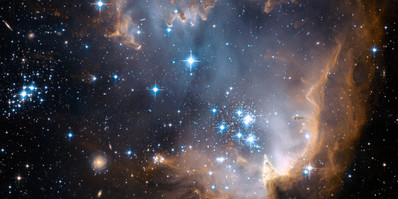 New stars being born in the N92 sector of the Small Magellanic Cloud
New stars being born in the N92 sector of the Small Magellanic Cloud By ancient tradition, the Church sets the dates for the coming year’s liturgical feast at the Epiphany Mass, based on the date for Easter. This year, we will celebrate the Great Pasch on March 27, and from our Epiphany perch at the top of the year we can see the year’s great mysteries opening before us. Isn’t it wonderful to celebrate these mysteries every year, going more deeply into their graces every time? God always gives us another chance….
Starz and the Star
Fr. Philip, the Russian Orthodox priest a few blocks over, called me today. He wondered if he could have some of our cast-off poinsettias for his Russian Christmas on Wednesday (January 6). He assumed that we Romans would have ended our Christmas festivities early, while the Russians were just getting going. I told him that we will be celebrating Christmas until next Sunday, but that we could come up with at least a dozen poinsettias for our Slavic brethren down the street. This is one of the joys of city life, to have so many interesting cultures and friends within a stone’s throw.
Epiphany is truly the day of gift giving: Jesus received gifts from the Magi, but the Magi received the far greater gift of seeing God face to face. St. Matthew tells us that the Magi were “overjoyed” at seeing the star, not only because of its shining brilliance, but because its beauty led them to the Savior. When they found Jesus and his Mother, they forgot all about the star! They prostrated themselves and did homage to the King of Kings, who makes the stars (have you ever seen those blazing images from the Hubble telescope of a “stellar nursery?” the Lord’ is continually giving birth to new stars!). But we poor humans commonly mistake the stars—sport stars, movie stars, political stars—for the Creator and Lord of the stars. My mind may wander from the altar at Mass, but it is glued to the TV screen when my favorite basketball star is poised to throw his three-pointer.
A Light shines in the darkness
The preface of the Mass often pinpoints the core mystery of a liturgical feast. Today’s preface describes Epiphany in these words: “When your Only begotten Son appeared in the substance of our mortality, he repaired us by the new light of his immortality” (my translation). Simply unveiling his divine face—by shining his “new” light upon us, Christ remakes us. The magi saw this light radiating from the baby’s face and it transformed them. Think of how a child’s smile can disarm us. Now think what it must’ve been for the Magi, the shepherds, St. Joseph and the Blessed Virgin Mary, to look into the face of Jesus. If only Herod would have looked into that baby’s face! The prolife movement most effectively changes hearts when it simply shows the face of the child to those who promote abortion.
Simply by shining on us, Christ’s light restores our humanity. No darkness can overcome our true humanity, born in the image of God. The revelation of that unconquerable light is essential to our faith, such that the traditional form of the Roman Rite repeats it after every Mass in the so-called Last Gospel: “The light shines in the darkness, and the darkness cannot overcome it.” Who knows what new forms of darkness this year might bring? Yet we begin this year with an unshakeable faith in the Light that cannot be overcome, the light streaming from Christ’s sacred face, the light reflected in the face of his Holy Mother, and all who join him in his saving mission. We must believe, as we enter this new year, that Christ’s light will not be overcome.



 RSS Feed
RSS Feed